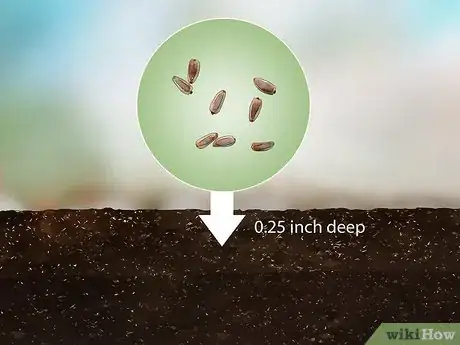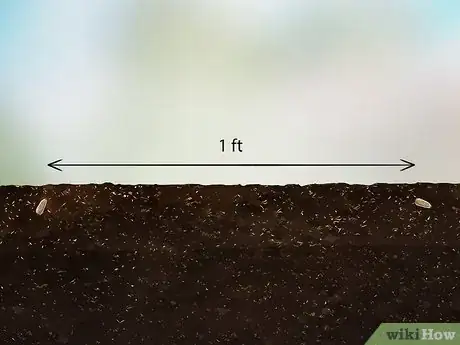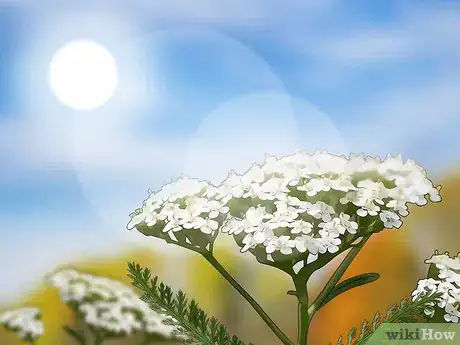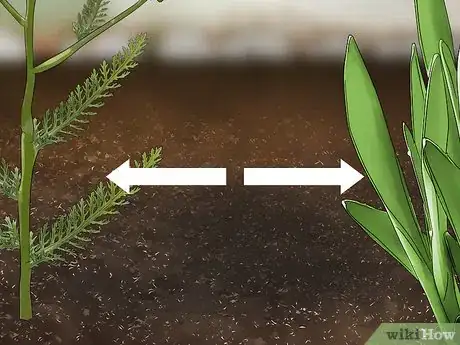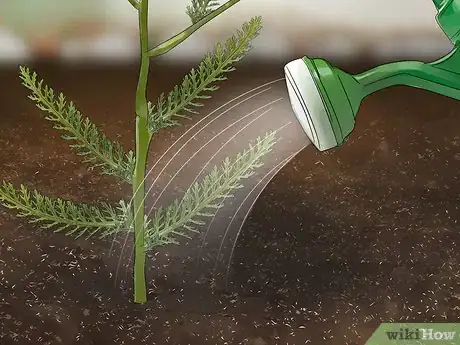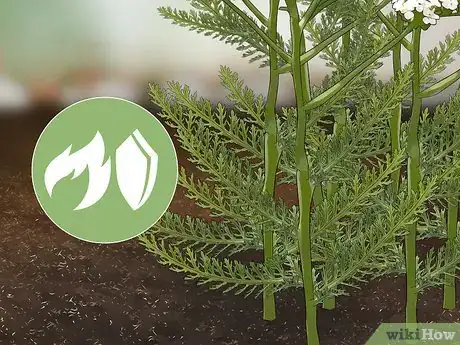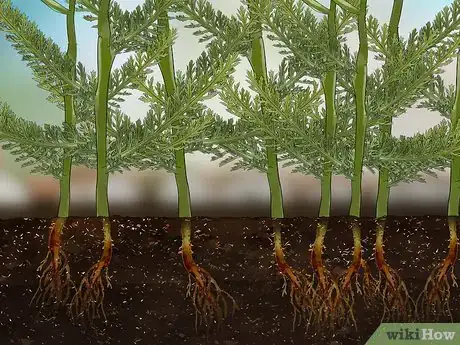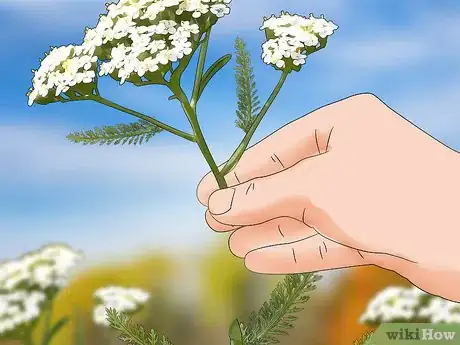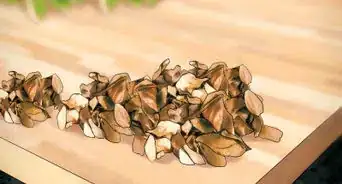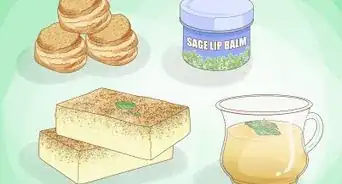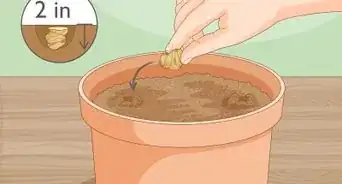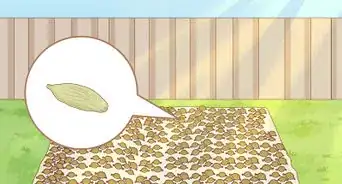X
This article was co-authored by Maggie Moran. Maggie Moran is a Professional Gardener in Pennsylvania.
There are 9 references cited in this article, which can be found at the bottom of the page.
This article has been viewed 45,421 times.
Yarrow (Achillea millefolium) is a common garden perennial with fern-like leaves and small blooms that are usually white but can also be yellow, pink or purple. Although yarrow is most known for its ability to grow in a variety of habitats, it is important to know the ideal conditions for growth and how to contain such a persistent plant. Once you’ve got the basics down, yarrow is a relatively easy plant to grow.
Steps
Part 1
Part 1 of 3:
Planting Yarrow Seeds
-
1Sow seeds in fall or early spring. Yarrow seeds need a cold, wet period to germinate, so you should sow the seeds in fall or early spring to give them time to begin blooming during spring and summer. The germination period usually lasts about two weeks.[1]
- You also have the option of transplanting
-
2Conduct the germination process indoors. If you choose to plant the seeds in late spring, you’ll want to complete a process called stratification that duplicates the cold, wet period needed to prepare temperate zone seeds for growing. Wrap the seeds in a wet paper towel and seal them in a plastic bag or put them in wet sand and refrigerate them for 4 weeks prior to planting.[2]Advertisement
-
3Position the seeds no deeper than 0.25 inches (0.64 cm) below the surface. Some light is needed for the germination process, so you don’t want to plant the seeds too deep.[3]
-
4Space the seeds 1–2 feet (0.30–0.61 m) apart. Yarrow produces large, robust roots, so you need to make sure you give the plant room to grow.[4]
-
5Transplant a mature yarrow if you're not using seeds. Like most perennials, yarrows can easily be transplanted from a pot to its new home. Dig a hole twice the size of the pot and make sure to water the plant and the new location thoroughly before transfer.
-
6Choose a sunny location to plant. Yarrow can tolerate some shade, but a full-sun area is ideal for the best growth. Too much shade can lead to flimsy stems, foliar disease, or rot.[8]
- Be aware that a humid climate can contribute to powdery mildew disease, which is mostly cosmetic but still something to consider.[9]
-
7Avoid soil with excessive moisture. Yarrow grows best in drier soil but will still flourish in moist soil if it is properly drained.[10] If you notice that the soil retains a lot of water or always looks wet, it’s probably not a good location to plant yarrow.
- Soils composed of sand tend to drain sufficiently, whereas clay-based soils do not. Creating a berm or raised bed with a mixture of clay and coarse sand can allow for better drainage if necessary.
-
8Give yarrow space. The roots become extremely dense once the plant matures. This can be beneficial for keeping weeds at bay but harmful for other plants.[11]
- You can take advantage of yarrow’s aggressive nature by using it to fill in areas of the garden where other plants can’t seem to grow, like sharp inclines or rocky soil.
Advertisement
Part 2
Part 2 of 3:
Caring for Yarrow
-
1Water your yarrow deeply at least once a week the first summer. Although yarrow likes dry soil, watering helps the plant develop its thick roots and sets the stage for longevity and growth. If rainfall is more than an inch per week, you can let nature take care of this step.[12]
- Once the plant has been established, no extra watering is required if located outside, especially on a an irrigated lawn.[13]
- Apply fertilizer to your yarrow, if needed.
-
2
-
3Dig up the plants and divide them every 3-4 years. Because yarrow can easily reseed and grows quickly, it can start to become unruly every few years. By thinning it out, you control which areas it spreads to and when. Using a gardening fork, start at the crown of the plant and gently work your way outward to lift the plant out of the ground. Then, divide into a few stalks per bunch by pulling or cutting if necessary and transplant the smaller bundles to their new home.[16]
-
4Allow for good airflow. Yarrow is prone to fungal disease, especially in humid climates. By making sure the leaves and blooms have good airflow, you can help prevent it.[17]
Advertisement
Part 3
Part 3 of 3:
Making Use of Yarrow
-
1Plant yarrow as a fire barrier. Yarrow doesn’t burn very easily, so it is sometimes used in areas that are prone to fires as a way to slow down a spreading fire. In fact, it is often the first plant to begin regrowth in the disturbed area and will actually flourish in these conditions.
-
2Prevent erosion. Yarrow thrives in areas with dry, thin soil which are prone to erosion. That characteristic combined with its deep, thick roots make it the perfect plant for this type of area.[18]
-
3Cut the blooms and dry them for decoration. Yarrow is often used in flower arrangements because the blooms last a long time once they’ve been cut. The also retain their shape and color well after being dried. Just hang them upside down in a dark, dry room, and enjoy them long after they have been cut.[19]
Advertisement
Expert Q&A
-
QuestionIs yarrow easy to grow from seed?
 Maggie MoranMaggie Moran is a Professional Gardener in Pennsylvania.
Maggie MoranMaggie Moran is a Professional Gardener in Pennsylvania.
Home & Garden Specialist It is not difficult to grow. Ideally, plant it 6-8 weeks prior to the last frost date, keep it in moist potting soil, and ensure it is in full sun.
It is not difficult to grow. Ideally, plant it 6-8 weeks prior to the last frost date, keep it in moist potting soil, and ensure it is in full sun. -
QuestionCan you eat yarrow?
 Maggie MoranMaggie Moran is a Professional Gardener in Pennsylvania.
Maggie MoranMaggie Moran is a Professional Gardener in Pennsylvania.
Home & Garden Specialist Yes, the flowers and leaves were used as a tea to treat fevers, reduce menstrual bleeding, and treat gastrointestinal problems.
Yes, the flowers and leaves were used as a tea to treat fevers, reduce menstrual bleeding, and treat gastrointestinal problems. -
QuestionHow do I prune yarrow?
 Maggie MoranMaggie Moran is a Professional Gardener in Pennsylvania.
Maggie MoranMaggie Moran is a Professional Gardener in Pennsylvania.
Home & Garden Specialist To prune yarrow, focus on deadheading the plant. This will help encourage new growth.
To prune yarrow, focus on deadheading the plant. This will help encourage new growth.
Advertisement
References
- ↑ https://cals.arizona.edu/yavapai/anr/hort/byg/archive/growingyarrow.html
- ↑ https://cals.arizona.edu/yavapai/anr/hort/byg/archive/growingyarrow.html
- ↑ https://cals.arizona.edu/yavapai/anr/hort/byg/archive/growingyarrow.html
- ↑ https://garden.org/plants/group/yarrows/
- ↑ http://www.birdsandblooms.com/gardening/flower-gardening/transplanting-perennials/
- ↑ https://cals.arizona.edu/yavapai/anr/hort/byg/archive/growingyarrow.html
- ↑ https://garden.org/plants/group/yarrows/
- ↑ http://www.bhg.com/gardening/plant-dictionary/perennial/yarrow/
- ↑ https://garden.org/plants/group/yarrows/
- ↑ https://garden.org/plants/group/yarrows/
- ↑ http://www.bhg.com/gardening/plant-dictionary/perennial/yarrow/
- ↑ https://garden.org/plants/group/yarrows/
- ↑ http://www.yolkandflour.com/in-the-garden/yarrow-the-friendship-plant/
- ↑ https://garden.org/plants/group/yarrows/
- ↑ http://www.gardenersworld.com/plants/plant-inspiration/how-to-cut-back-herbaceous-perennials/
- ↑ https://www.rhs.org.uk/advice/profile?pid=363
- ↑ https://www.gardeningchannel.com/growing-achillea-yarrow/
- ↑ http://calscape.org/Achillea-millefolium-()
- ↑ http://www.bhg.com/gardening/plant-dictionary/perennial/yarrow/
- ↑ http://www.yolkandflour.com/in-the-garden/yarrow-the-friendship-plant/
About This Article
Advertisement


